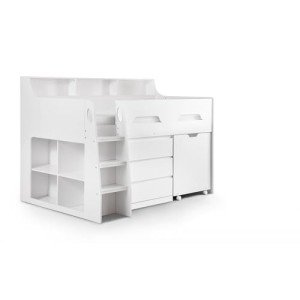Bunk Beds Sale's History History Of Bunk Beds Sale
Bunk Beds Sale: A Comprehensive Guide to Choosing the Right Bunk Bed for Your Home
Bunk beds have actually long been a staple in children's bed rooms, providing a combination of space-saving performance and fun. Whether accommodating brother or sisters, pals on pajama parties, or simply making the most of a playroom, bunk beds have actually ended up being an essential element in modern-day household homes. As sales on bunk beds increase, it becomes progressively essential for consumers to make informed decisions when buying one. This short article will cover the basics of buying a bunk bed, from types to safety features, in addition to suggestions for keeping the stability of your investment.
Types of Bunk Beds
When thinking about a bunk bed sale, it's important to understand the various designs readily available on the market. Below are the most common types:
Traditional Bunk Beds: These include two beds stacked one above the other, sharing a single frame. Recommended Resource site are frequently the most affordable choice.
L-Shaped Bunk Beds: This style includes one bed positioned vertically and another horizontally. This arrangement produces extra space below the upper bed, which can be used for storage or a backyard.
Lofted Beds: Similar to standard bunk beds however with no lower bed. Rather, the space underneath can be used for a desk, play location, or extra storage.
Triple Bunk Beds: For families with a larger number of kids or regular pajama parties, triple bunk beds provide 3 sleeping locations in a space-efficient style.
Futon Bunk Beds: These styles combine bunk beds and futon sofas. The bottom section converts into a different seating location, boosting performance.
Convertible Bunk Beds: These beds can be separated into 2 individual beds, making them versatile as kids's needs change gradually.
Table 1: Comparison of Bunk Bed Types
Type
Description
Space Efficiency
Extra Features
Traditional Bunk Bed
2 beds stacked vertically
High
Simplest design
L-Shaped Bunk Bed
One vertical and one horizontal bed
Moderate
Play or storage space
Lofted Bed
Raised bed with open space below
High
Work/play area
Triple Bunk Bed
Three stacked beds
Really High
Accommodates more users
Futon Bunk Bed
Bunk bed with a convertible futon
High
Multi-functional
Convertible Bunk Bed
Can be divided into 2 separate beds
Moderate
Flexibility & & longevity
Safety Features to Consider
Safety is vital when purchasing a bunk bed. Below are key safety features to search for:
Guardrails: Adequate guardrails should be present on both sides of the upper bunk to prevent falls. They should be at least 5 inches higher than the mattress.
Ladder Design: Look for strong, large ladders with slip-resistant rungs. Guarantee that the angle is not too steep for simple gain access to.
Stability: Ensure the bed is constructed with strong materials, such as strong wood or heavy-duty metal. click here for more info needs to not wobble when in usage.
Weight Limit: Check the weight capacity of the bunk bed to ensure it can accommodate the intended users securely.
Material Safety: If possible, choose beds made from non-toxic products or those satisfying security standards for kids's furnishings.
Table 2: Essential Safety Features
Feature
Description
Importance
Guardrails
Sides of upper bed to avoid falls
Essential for child security
Ladder Design
Strong, slip-resistant rungs
Aids safe and easy access
Stability
Develop quality to avoid wobbling
Makes sure safety and durability
Weight Limit
Optimum weight capability
Prevents mishaps
Material Safety
Non-toxic, safe materials
Safeguards kids's health
Maintenance Tips for Bunk Beds
To extend the life of your bunk bed and ensure continuous security, consider the following maintenance ideas:
Regular Inspections: Periodically check the structure for loose screws, bolts, or any signs of wear. Tighten fasteners as required.
Tidy Periodically: Dust and tidy the surfaces routinely. Use appropriate cleaners that won't harm the finish.
Examine Weight Limits: Be conscious of weight limitations, especially with older kids or adults who might wish to use the upper bunk.
Avoid Climbing on Guardrails: Educate children not to use guardrails for climbing or playing to reduce the risk of mishaps.
Regularly Asked Questions (FAQs)
Q1: What is the age limit for children to safely use bunk beds?A: While it differs by the manufacturer, lots of recommend that kids under 6 should not sleep in the upper bunk due to security issues.
Q2: How can moms and dads discourage hazardous climbing?A: Setting clear rules about bunk bed usage and supervising kids can help. Furthermore, utilizing a bed camping tent can discourage climbing up while creating an enjoyable sleep environment.
Q3: What should I think about when embellishing a room with bunk beds?A: Ensure there suffices space around the bunk bed for safe motion, and make use of the decoration to develop individualized spaces for each child.
Q4: Is a lofted bed ideal for older children?A: Yes, lofted beds can be ideal for older children as long as they satisfy safety requirements and the child is accountable enough to use them securely.
Bunk beds serve a practical function while including an aspect of enjoyable to a kid's bed room. As sales of bunk beds continue to rise, careful factor to consider of types, safety features, and maintenance practices is necessary for parents and caregivers. By comprehending these essential aspects, households can discover the ideal bunk bed for their home, guaranteeing both practicality and security for several years to come. Whether it's for brother or sisters sharing a room or producing a relaxing pajama party space, a well-chosen bunk bed can offer happiness and usefulness, making it a worthwhile investment.
